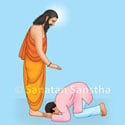Contents [hide]
This article provides information on what is a tsunami, some tips on what to do before a tsunami, signs of a tsunami, precautions to be taken during a tsunami, and what to do once a tsunami strikes.
|

Natural Calamities – Tsunami
1. What is a tsunami
A tsunami is a series of huge sea waves caused by an earthquake, an underwater landslide, a volcanic eruption, or an asteroid impact. (Reference : ready.gov/tsunamis)
Sometimes tsunamis can form water walls; (It is known as ‘tsunami bore’) but tsunamis are usually prone to rapid flooding. This is similar to the cycle of high and low tides. This can happen for a period of up to 10 minutes, 1 hour or 12 hours. (Reference : redcross.org/get-help/how-to-prepare-for-emergencies/types-of-emergencies/tsunami.html)
2. Precautions to survive a disaster
A. The house or building should be constructed as per the rules laid down by the Bureau of Indian Standards.
B. Educate yourself and your family about the dangers of a tsunami. Also practice evacuation methods.
C. Know the elevation of your residence above sea level, as well as the distance from the coast or other waterways.
D. If you are a tourist, you should know how to evacuate the house in a local tsunami.
E. If there is an earthquake and you are in the coastal area at that time, turn on the radio to check whether the administration has issued a tsunami warning.
F. Identify the safest and easiest way to reach the nearest highest point.
3. Signs of a tsunami
A. The sea suddenly retreats (hundreds of metres) and the shore becomes very large. This period can last for about 5-6 minutes. Then comes a sudden tsunami. Sometimes, on the other hand, the sea suddenly advances.
B. A sudden loud noise coming from the sea.
C. Experiencing large or long tremors of sudden earthquakes near the sea.
D. Suddenly a very large wall of water appears in the sea.
E. Animals near the sea, birds suddenly start to gather, get frightened or run away.
4. Measures to be taken during a tsunami
A. Keep calm. Do not panic.
B. Tsunami travels very fast, so save yourself, not your property.
C. Assist children, the elderly and the disabled, who may need special assistance.
D. Go to a safe place immediately if instructed by Government officials.
E. Get away from the water (at least 3 kilometres) as well as be on high ground (at least 30 metres high).
F. Stay away from beaches and river basins.
G. If it is not possible to go far, go to the roof of the nearest building that has a strong foundation.
H. If you are in water, hold on tightly to a floating object like a raft, tree trunk, wooden log, etc.
I. The difference in time between two tsunami waves can be a few minutes or a few hours. So even if the first tsunami comes, be prepared to face the next possible big wave.
J. During a tsunami, it is much more likely that people can be injured by waterborne objects. After a tsunami strikes, there is a risk of power lines breaking, buildings collapsing, etc.
K. If you are in a boat at sea, it is advisable to go deep sea (at least 45 metres deep) during a tsunami; because the height of tsunami waves in the deep sea is very less, and the waves are not as destructive as they are on shallow sea.
L. If you are in a port, go to the highlands.
5. Course of action after the tsunami
A. Return home only after disaster relief officials have declared the area to be safe.
B. Avoid going to areas affected by the disaster. Your presence may interfere with rescue and other emergency operations. Also, post-tsunami consequences such as contaminated water, collapsed roads, landslides, mudslides and other hazards can still pose a danger.
C. If a large earthquake (8-9 on the Richter scale or even greater) occurs before a tsunami strikes, an aftershock can reccur if the epicentre is nearby. Some aftershocks can be as high as 7 on the Richter scale and are capable of creating another tsunami. Aftershocks can take days, weeks or months to subside.
D. Stay away from objects that are carried along with the flowing water.
E. Before assisting the injured or the stranded, one should examine one’s own injuries and seek first aid as needed.
F. If someone needs to be rescued and you can’t, call a professional with the right equipment to help.
G. Children, the elderly and the disabled may need special assistance. Take care of them.
H. Use radio or television to get the latest information.
I. Tsunami water can damage buildings or cause walls to collapse. Therefore, stay away from any building that has stagnant water around it. Take precautions when re-entering the building or house. Wear protective clothing, and to avoid injury, be careful while cleaning.
J. If a tsunami has caused a large amount of water to enter your house, remove the sludge with water before it hardens.
K. Windows and doors should be left open to allow the house to be dried by the wind.
L. Do not eat or drink anything in the open.
M. If you need to evacuate your house, leave a message mentioning where you are going.
N. Do not spread rumours, nor believe in them.
To learn more about these times and how to survive them, please visit: https://www.sanatan.org/en/natural-disasters-and-survival-guide

 Cold wave : How to deal with it ?
Cold wave : How to deal with it ? How to deal with disasters such as World War, earthquakes, etc. ? (Part 3)
How to deal with disasters such as World War, earthquakes, etc. ? (Part 3) Landslides : How to deal with it ?
Landslides : How to deal with it ?